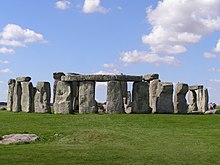England
| England | |
|---|---|

Location of England (dark green)
| |
| Status | Country |
| Capital and largest city |
London 51°30′N 0°7′WCoordinates: 51°30′N 0°7′W |
| National language | English |
| Regional languages | Cornish |
| Ethnic groups (2011) | |
| Religion | Church of England |
| Demonym | English |
| Government | Part of a constitutional monarchy |
• Monarch
| Elizabeth II |
| Parliament of the United Kingdom | |
| • House of Commons | 533 MPs (of 650) |
| Legislature | UK Parliament[a] |
| Establishment | |
| 5th–6th century | |
| 10th century | |
| 1 May 1707 | |
| Area | |
• Land
| 130,279 km2 (50,301 sq mi)[2] |
| Population | |
• 2016 estimate
|
|
• 2011 census
| 53,012,456 |
• Density
| 424.3/km2 (1,098.9/sq mi)[3] |
| GVA | 2015 estimate |
| • Total | £1.43 trillion($2.06 trillion, PPP[4])[5] |
| • Per capita | £26,159 ($37,747, PPP[4])[5] |
| Currency | Pound sterling (GBP; £) |
| Time zone | Greenwich Mean Time (UTC) |
• Summer (DST)
| British Summer Time (UTC+1) |
| Date format | dd/mm/yyyy (AD) |
| Drives on the | left |
| Calling code | +44 |
| Patron saint | Saint George |
| ISO 3166 code | GB-ENG |
| |
The area now called England was first inhabited by modern humans during the Upper Palaeolithic period, but takes its name from the Angles, a Germanic tribe deriving its name from the Anglia peninsula, who settled during the 5th and 6th centuries. England became a unified state in the 10th century, and since the Age of Discovery, which began during the 15th century, has had a significant cultural and legal impact on the wider world.[9] The English language, the Anglican Church, and English law – the basis for the common law legal systems of many other countries around the world – developed in England, and the country's parliamentary system of government has been widely adopted by other nations.[10] The Industrial Revolution began in 18th-century England, transforming its society into the world's first industrialised nation.[11]
England's terrain is chiefly low hills and plains, especially in central and southern England. However, there are uplands in the north (for example, the mountainous Lake District, and the Pennines) and in the west (for example, Dartmoor and the Shropshire Hills). The capital is London, which has the largest metropolitan area in both the United Kingdom and the European Union.[nb 1] England's population of over 53 million comprises 84% of the population of the United Kingdom, largely concentrated around London, the South East, and conurbations in the Midlands, the North West, the North East, and Yorkshire, which each developed as major industrial regions during the 19th century.[12]
The Kingdom of England—which after 1535 included Wales—ceased being a separate sovereign state on 1 May 1707, when the Acts of Union put into effect the terms agreed in the Treaty of Union the previous year, resulting in a political union with the Kingdom of Scotland to create the Kingdom of Great Britain.[13][14] In 1801, Great Britain was united with the Kingdom of Ireland (through another Act of Union) to become the United Kingdom of Great Britain and Ireland. In 1922 the Irish Free State seceded from the United Kingdom, leading to the latter being renamed the United Kingdom of Great Britain and Northern Ireland.
History
Prehistory and antiquity
Stonehenge, a Neolithic monument
The Beaker culture arrived around 2,500 BC, introducing drinking and food vessels constructed from clay, as well as vessels used as reduction pots to smelt copper ores.[34] It was during this time that major Neolithic monuments such as Stonehenge and Avebury were constructed. By heating together tin and copper, which were in abundance in the area, the Beaker culture people made bronze, and later iron from iron ores. The development of iron smelting allowed the construction of better ploughs, advancing agriculture (for instance, with Celtic fields), as well as the production of more effective weapons.[35]
Boudica led an uprising against the Roman Empire
The Romans invaded Britain in 43 AD during the reign of Emperor Claudius, subsequently conquering much of Britain, and the area was incorporated into the Roman Empire as Britannia province.[36] The best-known of the native tribes who attempted to resist were the Catuvellauni led by Caratacus. Later, an uprising led by Boudica, Queen of the Iceni, ended with Boudica's suicide following her defeat at the Battle of Watling Street.[37] This era saw a Greco-Roman culture prevail with the introduction of Roman law, Roman architecture, aqueducts, sewers, many agricultural items and silk.[38][39][40] In the 3rd century, Emperor Septimius Severus died at Eboracum (now York), where Constantine was subsequently proclaimed emperor.[41]
There is debate about when Christianity was first introduced; it was no later than the 4th century, probably much earlier. According to Bede, missionaries were sent from Rome by Eleutherius at the request of the chieftain Lucius of Britain in 180 AD, to settle differences as to Eastern and Western ceremonials, which were disturbing the church. There are traditions linked to Glastonbury claiming an introduction through Joseph of Arimathea, while others claim through Lucius of Britain.[42] By 410, during the Decline of the Roman Empire, Britain was left exposed by the end of Roman rule in Britain and the withdrawal of Roman army units, to defend the frontiers in continental Europe and partake in civil wars.[43] Celtic Christian monastic and missionary movements flourished: Patrick (5th-century Ireland) and in the 6th century Brendan (Clonfert), Comgall (Bangor), David (Wales), Aiden (Lindisfarne) and Columba (Iona). This period of Christianity was influenced by ancient Celtic culture in its sensibilities, polity, practices and theology. Local "congregations" were centred in the monastic community and monastic leaders were more like chieftains, as peers, rather than in the more hierarchical system of the Roman-dominated church




No comments:
Post a Comment